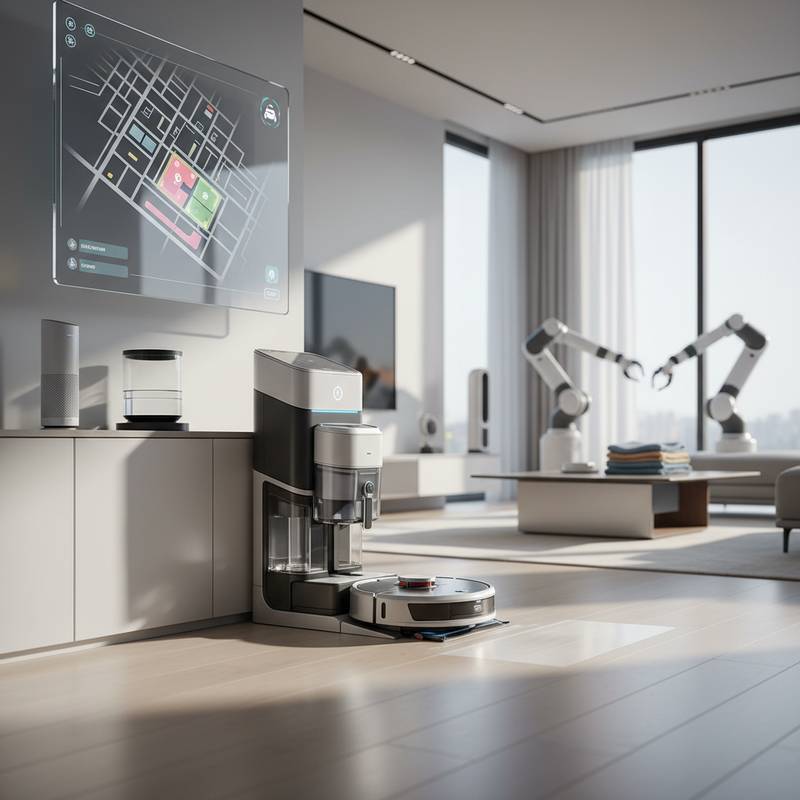The Future of Smart Cleaning: When Robot Vacuums Mop and Handle Laundry
Picture a robot vacuum gliding across floors, capturing dust while you enjoy coffee or focus on tasks. This scene seems advanced until a laundry pile or sticky kitchen floor demands attention. The vision of one robot managing all cleaning duties appears within reach, yet doubts linger. Recent advancements in smart cleaning robots bridge this divide swiftly.
The focus no longer centers on whether robots vacuum and mop. Discussions now explore subsequent capabilities. Folding laundry, emptying bins, and handling multi-surface cleaning emerge as possibilities. A unified system that maps home layouts, adapts to preferences, and performs routine cleaning with minimal oversight holds strong appeal.
Where We Are Now: Smarter, Faster, and Far More Capable
Robot vacuums progress from basic navigation to sophisticated mapping devices. Current models employ LiDAR sensors, AI for obstacle detection, and app controls that adapt to user routines. High-end units integrate vacuuming and mopping in single operations, adjusting suction and water levels for varied surfaces.
Consider the Roborock S8 Pro Ultra, priced at approximately $1,599. This device vacuums, mops, empties its bin, refills water, and cleans mop pads automatically. The Ecovacs Deebot X2 Omni, around $1,499, provides comparable features with enhanced edge cleaning and precise room mapping. For budget options, the iRobot Roomba Combo j5+ at about $699 offers reliable vacuuming plus a detachable mopping pad for light wet cleaning.
These models aim to reduce cleaning time while ensuring uniform outcomes. Users schedule sessions, define restricted areas, and track progress via apps. Integration with voice assistants such as Alexa or Google Home allows commands like "Clean the kitchen," directing the robot accurately.
The Next Leap: Mopping That Actually Works
Initial robot mops frequently produced streaks or overlooked dried spills. Advanced designs address these issues through superior pressure mechanisms and rotating mop heads. Hybrid units incorporate vibrating plates that simulate manual scrubbing.
The Roborock S8 series, for example, uses oscillating pads to apply targeted pressure. Paired with smart water regulation and integrated drying, these systems clean hard floors effectively. Select models heat mop pads post-use to eliminate streaks on tile or vinyl, prevent mildew, and prolong component lifespan. This feature delivers noticeable improvements in long-term performance.
Folding Laundry: The Next Big Frontier
A robot folding laundry evokes wonder, yet prototypes like FoldiMate and Laundroid demonstrate feasibility. Although those devices did not achieve widespread adoption, their innovations shape ongoing development. Researchers now develop modular robots that employ computer vision to classify clothing and execute folds.
Machine learning enables recognition of fabric types, garment forms, and folding techniques. Perfection remains elusive, but advancements accelerate. Future home robots may interface with laundry appliances, retrieving items from washers or dryers for organized stacking.
Integrated solutions will likely introduce this capability first. A smart washer-dryer pair could feature robotic arms or conveyors for fold assistance. View it as an expansion of vacuum automation: precision handling of repetitive, low-creativity tasks.
What to Expect from Multi-Task Robots
Envision a single robot coordinating vacuuming, mopping, and laundry folding on a set schedule. Modular attachments will define the forthcoming generation. A core unit might vacuum, while docks or add-ons manage laundry or dish rinsing.
Developers test shared AI cores, allowing robots to exchange data via cloud platforms. A vacuum could share maps with a lawn or window robot, refining paths for efficiency. This interconnected approach enhances multi-task performance significantly.
Choosing the Right Robot for Your Home
Upgrading requires staged consideration of features and costs. The following outlines options by price, highlighting benefits and ideal scenarios.
- Budget Tier (under $700)
- Example: iRobot Roomba Combo j5+
- What You Get: Essential vacuuming and basic mopping with self-emptying.
- Best For: Small spaces, pet households, or beginners in automation.
- Mid-Range Tier ($700 to $1,200)
- Example: Roborock Q Revo or Ecovacs Deebot T20 Omni
- What You Get: Enhanced suction, rotating mops, and auto-cleaning functions.
- Best For: Medium-sized homes with diverse floors and regular use.
- Premium Tier ($1,200 and above)
- Example: Roborock S8 Pro Ultra or Dreame X30 Ultra
- What You Get: Comprehensive automation including drying and fluid management.
- Best For: Expansive homes seeking minimal intervention.
Verify compatibility with existing systems like Alexa, Google Home, or Apple HomeKit. These platforms enable routines, such as initiating cleans upon departure or halting for deliveries.
Budget, Maintenance, and Real-World Use
Smart robots involve upfront investment but yield time savings and reliability. Capable hybrids range from $600 to $1,500. Yearly upkeep for filters, brushes, and pads totals $50 to $100.
In pet-friendly or busy homes, program deep cleans biweekly and daily light passes. Devices endure such schedules well. Regularly empty tanks, wipe sensors, and remove debris to sustain operation.
Prioritize safety by using only approved solutions in mops, avoiding vinegar or abrasives that damage components. For plumbed docks, engage a professional plumber to meet regulations.
Long-Term Vision: The Fully Autonomous Cleaning Ecosystem
Cleaning automation advances to total independence. Soon, robots will traverse floors, sort fabrics, and dispense supplies autonomously. These will form ecosystems linked to home networks.
Return to floors vacuumed, tiles mopped, and laundry folded. A central hub will sequence tasks per user patterns, offering suggestions like post-meal mopping or pre-guest vacuuming. Beyond ease, this liberates time for meaningful pursuits.
Integrating Automation into Your Routine
To embrace upcoming innovations, select a hybrid vacuum-mop with update support, self-cleaning docks, and app controls. Such choices ensure future compatibility.
During renovations, allocate space for docks near utilities. This preparation simplifies expansions. Cleaning technology simplifies daily life without supplanting human effort. Align your setup with emerging trends to realize hands-free potential.
